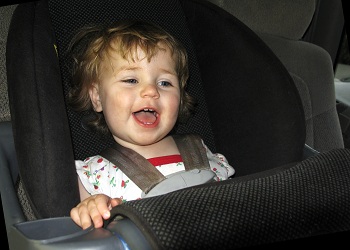Think that you have done everything you can to protect your children while he is driving your car? That may not be the case, according to a study by researchers at the University of Michigan. The study found that only a small percentage of US child passengers sat in age-appropriate car seats.
Researchers studied information collected from nearly 21,500 child passengers under the age of 13. They found that the older the children, the less likely they were to be properly restrained. Minority children were less likely to be in age-appropriate child restraints than their white counterparts, and children were less likely to be restrained when the car driver was not wearing a seat belt.
Study authors used a 2011 car seat standard from the American Academy of Pediatrics and the National Highway Traffic Safety Administration (NHTSA) to measure how appropriately children are restrained. They found that:
- Most parents remove their baby from a rear-facing car seat after age 1, while guidelines call for children to be in the seat until they are 2 years old.
- Fewer than 2 percent of children over 7 years use a booster seat, although guidelines suggest using it until the child reaches 57 inches, or 4¾ feet.
- Too many young children sit in the front seat even though the standards say they must remain in the back seat until age 13.
Using the right car seat can save your child’s life. Car crashes are the number 1 killer of US children ages 1 to 12. In 2010, an average of three children aged 14 and under were killed and 469 injured each day in US car crashes, according to the NHTSA.
Children who travel in a car seat have a much better chance of survival than those who don’t, according to NHTSA spokesman José Alberto Uclés. Research shows that for infants younger than 1 year old, using a safety seat reduces deaths in passenger car crashes by 71 percent and in light truck crashes by 58 percent. For children ages 1 to 4 years, use of a car seat reduced deaths by 54 percent in passenger car crashes and 59 percent in light truck crashes.
For children ages 4 to 7, use of a booster seat instead of just a seat belt can reduce the risk of injury by 59 percent, according to a study by The Children’s Hospital of Philadelphia.
Choosing the Best Seat
So why aren’t parents using safety seats properly? Some may not understand what is at stake.
“I don’t think a lot of parents realize that any time you switch from one type of child restraint to another, your child is going into a less secure seat option,” said Tess Benham, manager of home and community safety initiatives at the National Safety Council.
Rear-facing infant seats have a slight recline angle to protect the child’s neck and spine during impact; some of that protection is lost with the forward-facing seats. Child seats that use a five-point seat belt system – with two shoulder straps, two hip straps and a groin strap – provide more protection from injury than booster seats, which in turn are safer for children than seat belts.
Parents also may feel pressure from an older child who doesn’t want to sit in a car seat or booster seat.
“Families with multiple children, all child seat ages, can find it very difficult to find a safe seating position in the vehicle for all of them,” says Benham.
To make sure your child rides safely, see NTHSA site for the latest guidelines on child safety seats. You can also get personal (and usually free) help purchasing, installing, and using the proper child restraint at inspection stations across the US. NHTSA station locations can direct you to sites in your community.








